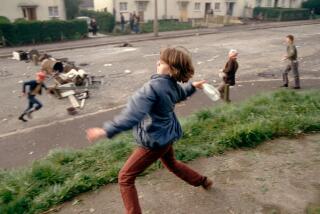Irish Police Face Peril of ‘Murder Mile’
- Share via
ARMAGH, Northern Ireland — The police sergeant commanding patrol Delta Foxtrot 108 dispassionately pointed out the killing ground like a tour guide in Rome or Paris reeling off historic buildings for tourists.
“We got two baddies there, Carroll and Grew. A militiaman was murdered at the same spot. At least five people have been killed on this one wee stretch. The Provos shot three policemen there. One took nine bullets, but he’s still walking around.”
This is “Murder Mile” on Armagh’s outskirts. The sergeant of the Royal Ulster Constabulary, a laconic native of Australia named Chris, listed 16 people slain on this one stretch of four-lane blacktop in the last four years.
The pocket-sized city is Ireland’s ancient ecclesiastical capital, the place where St. Patrick, the Emerald Isle’s patron saint, founded his first church.
But Armagh has become a vortex of violence in Northern Ireland’s 15 years of sectarian and political bloodletting, Ulster’s agony in microcosm, as members of the the Provisional Wing of the Irish Republican Army--Provos--try to drive the British out of Protestant-dominated Northern Ireland, unite it with the Catholic Irish Republic and create a socialist state.
Delta Foxtrot’s mission on this day: Check road culverts for mines planted by the IRA, set up roadblocks and check out the “faces,” known or suspected activists, in Catholic housing developments around Armagh.
The patrol mounted up in Gough Barracks, the constabulary’s fortified interrogation center in the south of the province. The IRA calls it a “torture center.”
Delta Foxtrot’s gray Land Rover, its bodywork dented in a score of attacks, had quarter-inch steel armor, gun ports on the sides, and back and metal grilles over the windshield to keep out bricks and gasoline bombs.
“We keep the doors closed all the time, even in summer,” Chris says. “A ricocheting bullet can play hell inside.”
Steel Door Shut Pete, the driver, survived an attack three nights before. Two grenades lobbed from a house blew the back off his patrol car. He escaped with hardly a scratch.
Freddie, an inspector, was along for the ride. David, the burly rear gunner, clanged the vehicle’s steel door shut as it bumped out through the gates of the barracks.
Everyone wore bulletproof vests. Ammo clips clanged on the metal floor. The radio hissed and crackled with the terse, coded chatter between patrols and headquarters.
The police have killed six men they said were known or suspected gunmen of the IRA or its Marxist offshoot, the Irish National Liberation Army, in disputed circumstances around Armagh in the last couple of years.
Roddy Carroll and Seamus Grew, the pair cited by Chris, were both top Liberation Army gunhands. They were shot in a police ambush Dec. 12, 1982.
Both were unarmed, drawing further allegations from the Catholic side that the security forces are waging a “shoot to kill” campaign. The policeman who shot them was acquitted of murder despite his admission that he took part in a cover-up, ostensibly to protect an informer.
None of Delta Foxtrot’s crew shed any tears for Carroll and Grew. Freddie noted coldly: “They’d both served time. They were involved up to their necks.”
Dominant Role The Royal Ulster Constabulary, the province’s overwhelmingly Protestant police force, has since 1976 taken the dominant role in the war against the gunmen.
Since 1972, when the British Army had 22,000 regulars in the province, military strength has been cut to 8,500. Constabulary strength has swelled from 4,000 in the mid-1970s to 8,500 officers backed by 4,400 reservists. It’s part of Britain’s plan to increase security by using local forces as much as possible.
The force has moved back into staunch IRA nationalist areas where once it could only go escorted by the army. But driving around in armored vehicles, guns at the ready, hardly rates as “normal policing.”
As the patrol headed for the first culvert, Chris, an 11-year constabulary veteran, gave Pete silent directions by pointing his finger at the turns he wanted--no set pattern to avoid ambushes.
The Provos used the culvert three weeks earlier to blow up a police car with a land mine. The three crewmen were wounded but survived.
500-Pound Mines
“They were very, very lucky,” Chris says. “It doesn’t usually happen that way when you get hit by a mine. They use anything from 100 to 1,000 pounds of explosives; 500 pounds is the average.”
Chris parked 50 yards from the culvert. The patrol fanned out, covering the road and the trees in case of ambush.
Cradling his U.S.-made Ruger rifle in his arm, Chris swung out in a circle to approach from downstream. The culvert was empty. But that didn’t mean much.
“We’ll check it again later,” Chris explained. “They can hook up a mine in three minutes, usually a milk churn or a beer keg.
“One patrol was lured in by a hoax call about a bomb. They checked it out and found nothing. Coming back they were blown up.
“These country roads are crisscrossed with culverts and drains. Any one could contain enough stuff to blast us off the road.
“That’s part of the risk. These boys know that on these roads they can be hit by a bomb or snipers.”
More than 200 police men and women have been killed since “The Troubles” erupted in August 1969. Many were slain in land-mine ambushes on country roads like those Delta Foxtrot was traveling.
Even ex-policemen are targets.
One retired officer triggered a booby-trap when he opened his garage door to park his car after a night out with friends.
Yet police officials say that every vacancy in the reserve attracts five volunteers ready to brave a deadly ambush.
Vulnerable Through Families
“It’s always at the back of your mind,” says Freddie. “You learn to live with it. But we’re all at our most vulnerable through our families. They suffer the most. The kids seem to adapt; it’s all they’ve ever known.
“The wives can take it hard. Every time a policeman’s killed, they wonder, wait for the doorbell to ring. It usually doesn’t. But one day. . . .
“I check under the car and the hood every day. Too many people have been blown up by booby traps when they switched on the ignition.”
Constabulary officers are allowed to change the plates on their cars every few months so the IRA can’t get a line on them. Most vary their routes so they don’t set a pattern that one day could end in an ambush. Their full names can’t be published, nor can full-face photos.
Delta Foxtrot swung back into Armagh, the pointed spires of its twin cathedrals--one Protestant, one Catholic--poking into clouds scudding across the countryside.
No Nice Guys
In Dromagh Park, a Catholic area, Chris sat with a handwritten list of suspect cards, checking license plates, as he took the patrol past the houses of suspected activists.
“We’re looking for anything out of the ordinary,” he says. “You don’t stop and try to be the nice guy around here.”
He stiffened when he spotted a man in his late 30s, dressed in a crumpled tweed jacket, open-necked shirt and stained jeans.
“There’s a sus,” he said. Sus is shorthand for “suspected person.”
He named the man and snorted: “We’ve searched his place a dozen times but never got anything. His name’s always cropping up. He’s always around. We know he’s involved.
“It may not look like we’re achieving much just driving around like this, but it’s a stabilizing influence, an inhibiting factor. They know we’re here. They never know where we’re going to put up a checkpoint.
“Preventing terrorism is our first priority, but you never know how many bombs you may have prevented or terrorists you’ve scared off.”
More to Read
Sign up for Essential California
The most important California stories and recommendations in your inbox every morning.
You may occasionally receive promotional content from the Los Angeles Times.













